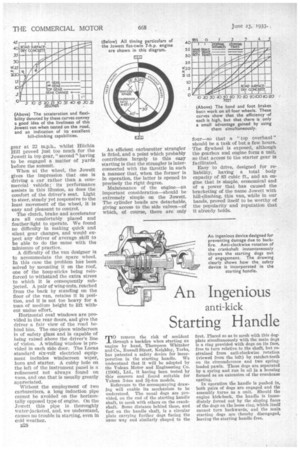An Ingenious
Page 42

If you've noticed an error in this article please click here to report it so we can fix it.
anti-kick
Starting Handle
TO remove the risk of accident through a backfire when starting an engine by hand, Thompson 'Whitaker and Co., Russell Street, Reighky, Yorks, has patented a safety device for incorporation in the starting handle. We understand that it will be adapted by the Vulcan Motor and Engineering Co. (1906), Ltd., it having been tested by this concern and found suitable for Vulcan 3-ton and 3i-ton models.
Reference to the accompanying drawing will enable its mechanism to be understood. The usual dogs are provided, on the end of the starting handle shaft, to mesh with others on the crankshaft. Some distance behind these, and fast on the handle shaft, is a circular Plate carrying further dogs facing the same way and similarly shaped to the
first. Placed so as to mesh with this dogplate simultaneously with the main dogs is a ring provided with dogs on its face, free to turn relative to the shaft, but restrained from anti-clockwise rotation
• (viewed from the left) by ratchet-teeth on its circumference and two springloaded pawls. These dogs are separated by a spring and run in oil in a housing formed as an extension of the crankcase casting,.
In operation the handle is pushed in, both pairs of dogs are engaged and the assembly tarns as a unit. Should the engine kick-back, the handle is immediately forced out by the sloping faces of the dogs on the loose ring, which itself cannot turn backwards, and the main starting dogs are thereby disengaged, leaving the starting handle free.




























































































